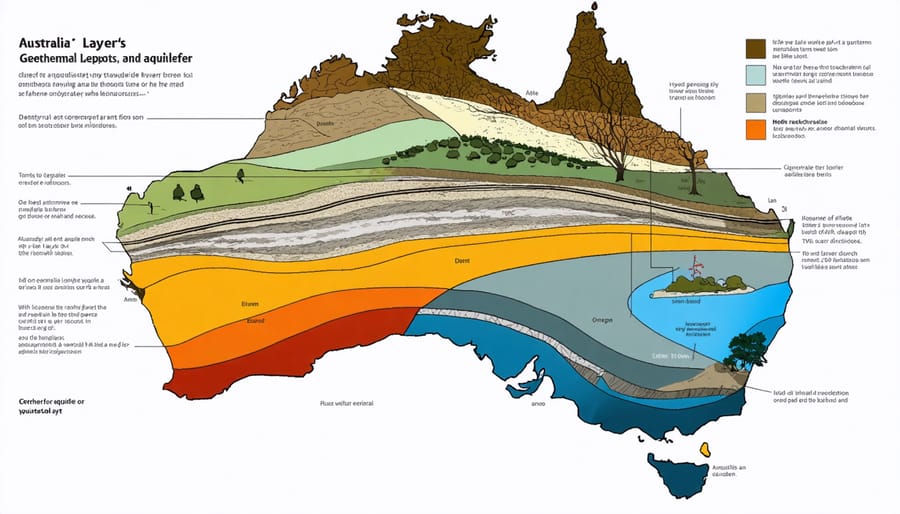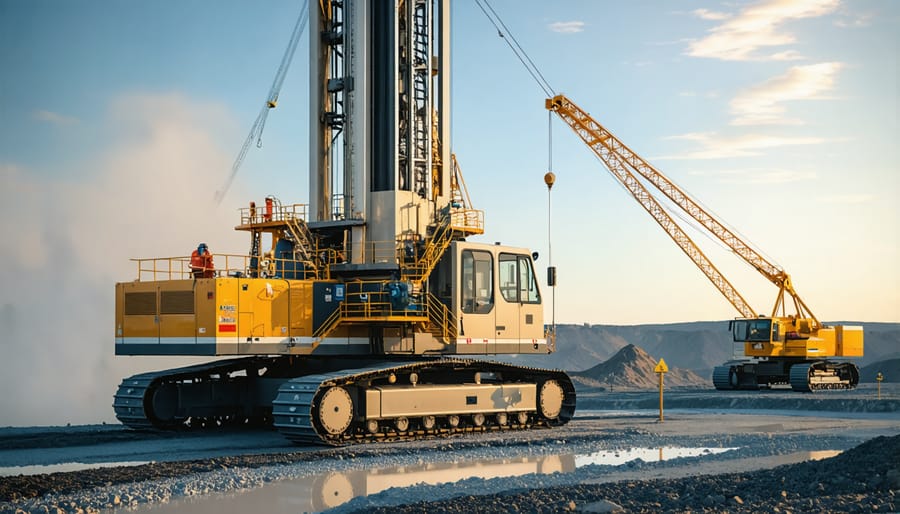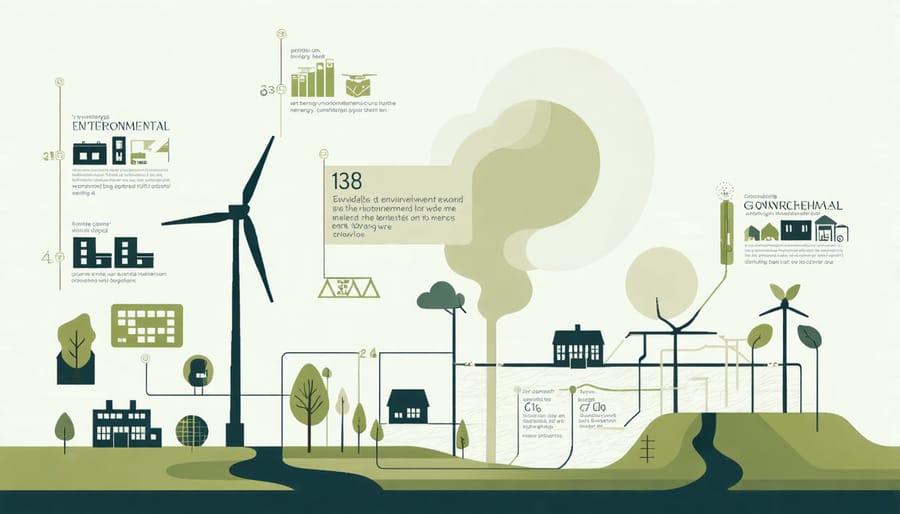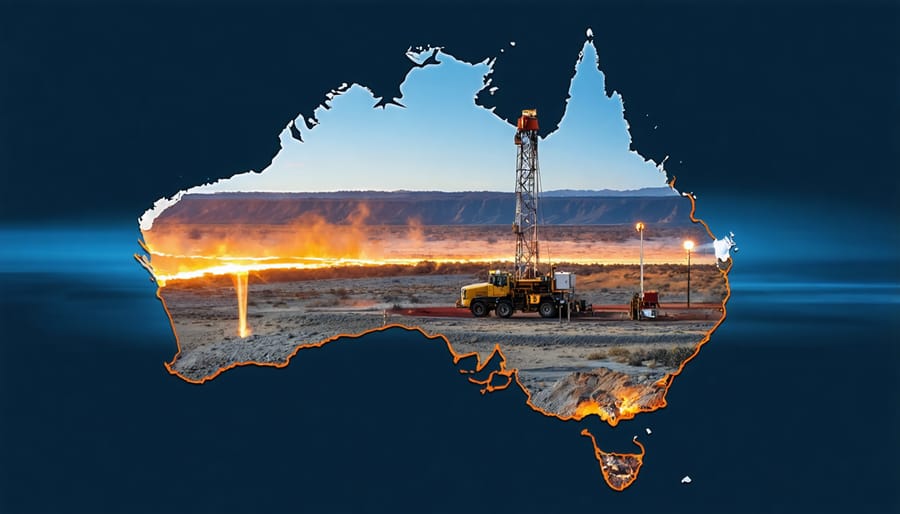Deep beneath Earth’s surface lies an energy revolution waiting to be unleashed. As we forge ahead toward a sustainable energy future, geothermal power stands poised to transform how we power our world. Unlike intermittent solar and wind resources, geothermal energy offers an unwavering, 24/7 clean power source that could meet up to 20% of global electricity demand by 2050.
Recent technological breakthroughs in enhanced geothermal systems (EGS) and advanced drilling techniques are unlocking previously inaccessible heat reservoirs, dramatically expanding potential geothermal sites across Australia and beyond. With costs plummeting by over 50% in the past decade and new projects achieving grid parity, geothermal energy is rapidly evolving from a niche renewable to a mainstream power source.
This vast, untapped energy resource promises not just clean electricity, but also sustainable heating, cooling, and industrial applications that could revolutionize sectors from agriculture to manufacturing. As we stand at this pivotal moment, understanding geothermal energy’s future reveals how this ancient heat source could help solve modern energy challenges while creating thousands of green jobs and driving economic growth.
Australia’s Untapped Geothermal Resources

Hot Sedimentary Aquifers
Hot sedimentary aquifers represent one of the most promising frontiers in geothermal energy, particularly for Australia’s vast sedimentary basins. These underground reservoirs of hot water, trapped within porous rock formations, offer a more accessible and cost-effective approach to geothermal power generation compared to traditional methods.
Unlike conventional geothermal systems that require drilling into hard rock, hot sedimentary aquifers are found in softer, more permeable rock layers. This geological characteristic makes them easier and cheaper to access, with drilling costs significantly lower. In Australia, the Great Artesian Basin stands out as a prime example, with temperatures reaching up to 100°C at economically viable depths.
The beauty of hot sedimentary aquifers lies in their widespread availability and relatively shallow depths. These systems can provide both electricity generation and direct heat applications, making them ideal for industrial processes, agriculture, and district heating. Recent technological advances in drilling and heat exchange systems have made tapping into these resources more efficient than ever before.
What’s particularly exciting is that many of these aquifers are located near existing power infrastructure and population centers, reducing the costs of power transmission and distribution.
Enhanced Geothermal Systems
Enhanced Geothermal Systems (EGS) represent a game-changing advancement in harnessing Earth’s heat, pushing the boundaries of traditional geothermal energy extraction. By creating artificial reservoirs in hot dry rock formations several kilometres beneath the surface, EGS technology opens up vast new possibilities for geothermal power generation across Australia.
Unlike conventional systems that rely on naturally occurring hot water reservoirs, EGS involves drilling deep wells and injecting water to create artificial fracture networks. This revolutionary approach means we can tap into geothermal resources practically anywhere, not just in volcanic or tectonically active regions.
The Cooper Basin in South Australia stands out as a prime example of EGS potential, with rock temperatures reaching over 240°C at depths of 4-5 kilometres. These deeper resources could potentially provide thousands of megawatts of clean, reliable power for centuries to come.
Recent technological breakthroughs in drilling techniques and reservoir stimulation methods have significantly improved the economic viability of EGS projects. With continued investment and development, EGS could become a cornerstone of Australia’s renewable energy future, providing stable baseload power to complement solar and wind generation.
Technological Breakthroughs Driving Growth
Advanced Drilling Techniques
The landscape of geothermal drilling is transforming rapidly, with innovative techniques making this renewable energy source more accessible and cost-effective than ever before. Advanced drilling technologies, particularly millimeter wave drilling and plasma drilling, are revolutionising how we access underground heat reservoirs.
Millimeter wave drilling uses concentrated electromagnetic energy to effectively ‘melt’ through rock formations, significantly reducing the wear and tear on drilling equipment while increasing penetration rates. This breakthrough has already shown promising results in pilot projects, cutting drilling costs by up to 30% compared to conventional methods.
Enhanced directional drilling capabilities now allow engineers to access geothermal resources from multiple angles from a single surface location, minimising environmental impact and reducing overall project footprints. This is particularly valuable in environmentally sensitive areas across Australia’s diverse landscape.
Artificial Intelligence and machine learning are also playing crucial roles in optimising drilling operations. Smart drilling systems can now predict and adjust to changing geological conditions in real-time, reducing risks and improving efficiency. These systems can detect potential problems before they occur, saving both time and resources.
Perhaps most exciting is the development of closed-loop systems, which require less water and produce minimal emissions during operation. These systems, combined with advanced drilling techniques, are making geothermal energy viable in locations previously considered unsuitable, opening up new possibilities for renewable energy generation across Australia.

Smart Grid Integration
The integration of geothermal energy into modern power grids is becoming increasingly sophisticated, thanks to advanced smart grid technologies and innovative control systems. These developments are transforming geothermal from a steady baseline power source into a more flexible and responsive energy partner.
Modern geothermal plants now incorporate real-time monitoring and automated response systems, allowing them to adjust output based on grid demands. This adaptability is particularly valuable in Australia’s evolving energy landscape, where renewable integration is rapidly expanding. Smart inverters and advanced power electronics enable geothermal facilities to provide essential grid services, including voltage support and frequency regulation.
The future looks even more promising with the emergence of hybrid systems. By combining geothermal with other renewable sources like solar and wind, operators can create more reliable and efficient power networks. These integrated systems use sophisticated algorithms to optimize power distribution, ensuring maximum efficiency and minimal waste.
In Western Australia’s Perth Basin, pioneering projects are already demonstrating how geothermal can work seamlessly with existing infrastructure. These systems use advanced load-following capabilities to match power generation with demand patterns, making geothermal an increasingly attractive option for grid stabilization and energy security.
As we move towards a fully renewable grid, geothermal’s ability to provide both baseload power and grid support services will become increasingly valuable, helping to create a more resilient and sustainable energy network for Australia’s future.

Economic and Environmental Benefits
Job Creation and Industry Growth
The geothermal energy sector is emerging as a significant job creator, with projections showing robust growth in employment opportunities across Australia. From drilling specialists and geologists to power plant operators and maintenance technicians, the industry offers diverse career paths for both skilled workers and professionals.
Recent industry analyses suggest that for every geothermal power plant developed, approximately 100 direct jobs are created during construction, with 10-20 permanent positions required for ongoing operations. These numbers multiply when considering indirect employment in supporting industries such as manufacturing, consulting, and research and development.
The sector is particularly promising for regional communities, where most geothermal resources are located. Areas like the Cooper Basin in South Australia and the Great Artesian Basin are becoming hubs for geothermal development, creating local employment opportunities and stimulating regional economies.
Additionally, the growth of geothermal energy is fostering innovation in related industries, including heat pump manufacturing, drilling technology, and thermal storage solutions. This ripple effect is creating new business opportunities and driving technological advancement across the renewable energy sector, positioning Australia as a potential leader in geothermal expertise and technology exports.
Carbon Reduction Impact
Geothermal energy stands as a powerful ally in the fight against climate change, offering one of the most effective pathways to achieving zero carbon emissions goals. Unlike fossil fuels, geothermal power plants emit virtually no greenhouse gases during operation, making them an ideal solution for decarbonising our energy sector. A typical geothermal plant produces just 5% of the carbon emissions of a coal-fired facility, while delivering the same reliable baseload power.
The environmental impact becomes even more significant when considering geothermal’s potential scale in Australia. Conservative estimates suggest that if we were to harness just 1% of our continent’s geothermal resources, we could reduce our national carbon emissions by up to 25% by 2050. This remarkable potential for carbon reduction doesn’t stop at electricity generation – geothermal heating and cooling systems in buildings can slash emissions by up to 80% compared to conventional HVAC systems.
What’s particularly exciting is the minimal land footprint required. A geothermal plant uses just a fraction of the space needed for solar or wind farms while providing constant, emissions-free power around the clock.
Challenges and Solutions
Infrastructure Requirements
The expansion of geothermal energy requires significant infrastructure development, particularly in power distribution networks capable of handling this sustainable energy source while transforming Australia’s energy landscape. Key requirements include upgrading existing power grids to accommodate the steady baseload power that geothermal plants provide, installing specialized transmission lines that can handle high temperatures, and developing robust interconnection points between geothermal facilities and the national grid.
Australian communities will need smart grid technologies to efficiently distribute geothermal power across vast distances, particularly from remote geological hotspots to urban centres. These smart systems will enable real-time monitoring and adjustment of power flow, ensuring optimal distribution and minimal energy loss.
Storage solutions also play a crucial role in the infrastructure equation. While geothermal provides consistent power, integrating it with other renewable sources requires modern battery systems and thermal storage facilities. This helps maintain grid stability and ensures continuous power supply during maintenance periods.
Local councils and energy providers must also invest in upgrading substations and transformers to handle geothermal power’s unique characteristics. This includes installing specialized equipment that can manage the heat and pressure associated with geothermal energy production, as well as implementing advanced cooling systems where necessary.
These infrastructure improvements will create opportunities for regional development and job creation, particularly in areas near geothermal resources. The investment in such infrastructure will ultimately support Australia’s transition to a more sustainable energy future.
Policy and Investment Landscape
The policy landscape for geothermal energy in Australia is experiencing a significant shift, with increasing government support through renewable energy targets and financial incentives. The Australian Renewable Energy Agency (ARENA) has committed substantial funding to geothermal exploration and demonstration projects, signaling strong federal backing for this emerging sector.
State governments are also stepping up, introducing their own renewable energy initiatives that include geothermal development. Victoria and South Australia are leading the charge with streamlined approval processes and dedicated geothermal resource zones, making it easier for developers to establish new projects.
However, industry experts argue that more comprehensive policy frameworks are needed to accelerate geothermal adoption. This includes the introduction of feed-in tariffs specifically for geothermal power, tax incentives for early-stage exploration, and reduced red tape for project approvals.
Investment in geothermal energy is gaining momentum, with both domestic and international investors showing increased interest. Major energy companies are diversifying their portfolios to include geothermal projects, while venture capital firms are funding innovative startups developing new drilling and heat extraction technologies.
To fully unlock geothermal’s potential, stakeholders emphasize the need for more public-private partnerships, increased research funding, and better integration with existing power infrastructure. The creation of geothermal innovation hubs and knowledge-sharing networks could also help accelerate technology development and commercial deployment across the country.
The future of geothermal energy in Australia stands at a pivotal moment, poised to play a transformative role in our nation’s renewable energy landscape. As we’ve explored throughout this discussion, the combination of advancing technology, growing investment, and increasing environmental awareness creates a perfect storm for geothermal energy’s expansion.
The path forward is clear: we must embrace this sustainable power source with both enthusiasm and strategic planning. Australia’s unique geological advantages, coupled with our technical expertise and innovation capability, position us perfectly to become a global leader in geothermal energy development.
To realize this potential, we need collaborative action from all sectors. Government support through policy frameworks and funding initiatives must continue to grow. Private sector investment in research and development will drive technological improvements and cost reductions. Communities and individuals can contribute by supporting local geothermal projects and advocating for renewable energy adoption.
The time to act is now. With climate change accelerating and traditional energy sources becoming increasingly problematic, geothermal energy offers a reliable, clean, and sustainable solution. By investing in geothermal technology today, we’re not just securing our energy future – we’re creating jobs, stimulating economic growth, and protecting our environment for generations to come.
Let’s embrace this opportunity to power our future sustainably. Together, we can make geothermal energy a cornerstone of Australia’s renewable energy revolution.

